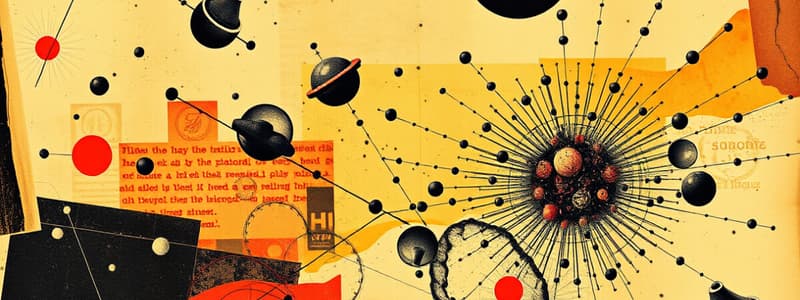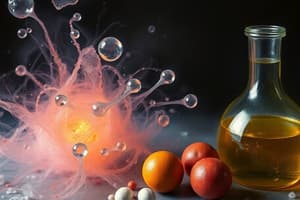Podcast
Questions and Answers
Which of the following items are composed of matter? (Select all that apply)
Which of the following items are composed of matter? (Select all that apply)
- Ice on a pond (correct)
- Air inside a balloon (correct)
- Clouds in the sky (correct)
- Thoughts
Match the subatomic particles with their descriptions:
Match the subatomic particles with their descriptions:
Protons = Positively charged Electrons = Outside the nucleus Neutrons = No charge Protons & Neutrons = Have significant mass
How many protons, neutrons, and electrons does a neutrally charged Carbon atom have?
How many protons, neutrons, and electrons does a neutrally charged Carbon atom have?
Protons - 6, Neutrons - 6, Electrons - 6
How does Carbon-14 differ from Carbon-12?
How does Carbon-14 differ from Carbon-12?
Complete the table by entering the correct number of protons and neutrons for each isotope: Hydrogen-2: P - __, N - __
Complete the table by entering the correct number of protons and neutrons for each isotope: Hydrogen-2: P - __, N - __
Complete the table by entering the correct number of protons and neutrons for each isotope: Carbon-12: P - __, N - __
Complete the table by entering the correct number of protons and neutrons for each isotope: Carbon-12: P - __, N - __
Complete the table by entering the correct number of protons and neutrons for each isotope: Carbon-14: P - __, N - __
Complete the table by entering the correct number of protons and neutrons for each isotope: Carbon-14: P - __, N - __
Complete the table by entering the correct number of protons and neutrons for each isotope: Nitrogen-14: P - __, N - __
Complete the table by entering the correct number of protons and neutrons for each isotope: Nitrogen-14: P - __, N - __
Complete the table by entering the correct number of protons and neutrons for each isotope: Oxygen-17: P - __, N - __
Complete the table by entering the correct number of protons and neutrons for each isotope: Oxygen-17: P - __, N - __
What are the reactants and products in the process of photosynthesis?
What are the reactants and products in the process of photosynthesis?
What is the difference between an anion and a cation?
What is the difference between an anion and a cation?
How many protons does an ion with 24 electrons and a charge of +3 contain?
How many protons does an ion with 24 electrons and a charge of +3 contain?
Which of the following describe a chemical bond? (Select all that apply)
Which of the following describe a chemical bond? (Select all that apply)
Classify each statement as applying to ionic bonds, covalent bonds, or both:
Classify each statement as applying to ionic bonds, covalent bonds, or both:
Determine whether each of the statements or molecules below refers to a polar bond or a nonpolar bond:
Determine whether each of the statements or molecules below refers to a polar bond or a nonpolar bond:
Which of the following scenarios illustrates the high heat of vaporization of water?
Which of the following scenarios illustrates the high heat of vaporization of water?
How does the specific heat of water influence biological systems?
How does the specific heat of water influence biological systems?
What property of water molecules leads to the high surface tension of liquid water?
What property of water molecules leads to the high surface tension of liquid water?
What is the typical pH of biological fluids in humans, such as blood and extracellular fluid?
What is the typical pH of biological fluids in humans, such as blood and extracellular fluid?
A buffer is a substance that...
A buffer is a substance that...
Why is carbon so prevalent in biological molecules, such as proteins?
Why is carbon so prevalent in biological molecules, such as proteins?
If the solid form of most molecules is heavier than the liquid form, why does ice float?
If the solid form of most molecules is heavier than the liquid form, why does ice float?
Which of the following examples illustrates how the property of ice floating on water supports life on Earth? (Select all that apply)
Which of the following examples illustrates how the property of ice floating on water supports life on Earth? (Select all that apply)
Select the descriptions of the ways hydrocarbon skeleton structures may vary. (Select all that apply)
Select the descriptions of the ways hydrocarbon skeleton structures may vary. (Select all that apply)
Flashcards are hidden until you start studying
Study Notes
Matter Composition
- Air inside a balloon, clouds, and ice on a pond are composed of matter.
Subatomic Particles
- Protons carry a positive charge.
- Electrons carry a negative charge and are located outside the nucleus.
- Neutrons have no charge and are found in the nucleus.
- Protons and neutrons have significant mass and comprise the nucleus.
Carbon Atom Structure
- A neutral carbon atom contains 6 protons, 6 neutrons, and 6 electrons.
- Carbon-14 differs from Carbon-12 by having two additional neutrons.
Isotope Composition
- Hydrogen-2: 1 proton, 1 neutron
- Carbon-12: 6 protons, 6 neutrons
- Carbon-14: 6 protons, 8 neutrons
- Nitrogen-14: 7 protons, 7 neutrons
- Oxygen-17: 8 protons, 9 neutrons
Photosynthesis Process
- Photosynthesis produces glucose (C6H12O6) and oxygen (O2) from carbon dioxide (CO2) and water (H2O).
- Carbon dioxide and water serve as reactants; glucose and oxygen are products.
Ion Differences
- Anions possess a negative charge, whereas cations have a positive charge.
Ion Particle Count
- An ion with 24 electrons and a +3 charge has 27 protons.
Chemical Bonds
- Chemical bonds involve sharing electrons or interaction between oppositely charged ions.
- Ionic bonds form between oppositely charged ions and dissociate in polar water.
- Covalent bonds involve sharing electrons and remain intact in water, crucial for biomolecules.
Bond Classification
- Polar bonds: unequal sharing of electrons, featured in water, with partial charges.
- Nonpolar bonds: equal sharing of electrons, as in diatomic hydrogen (H2).
Water Properties
- High heat of vaporization of water cools the skin after swimming.
- High specific heat allows organisms to maintain stable temperatures.
- Hydrogen bonds between water molecules contribute to high surface tension.
pH in Biological Systems
- Typical pH of human biological fluids is 7.4.
- Buffers regulate pH by accepting or releasing hydrogen ions.
Carbon in Biological Molecules
- Carbon's ability to form four covalent bonds allows diverse molecular shapes and bonding with hydrogen to create hydrocarbons.
Ice and Density
- Ice floats because its crystalline structure is less dense than liquid water.
Ice's Role in Ecosystems
- Floating ice creates habitats for arctic and antarctic animals and ensures aquatic life survives when water freezes.
Hydrocarbon Variability
- Hydrocarbon skeletons can vary in ring structures, branching, length, and the position of double bonds.
Studying That Suits You
Use AI to generate personalized quizzes and flashcards to suit your learning preferences.




